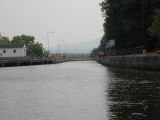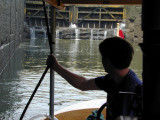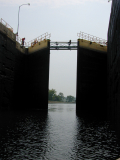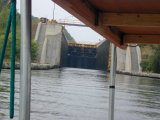Locks
Contact
When we were about a mile from a lock, Al would signal the lockmaster
on Channel 13 of the VHF radio. “Lock 9, Lock 9, this is the steamboat
Aurora Borealis eastbound. Over.” The lockmaster would reply,
“This is Lock 9. Over.” Al would ask to go through the lock and the
lockmaster would reply, “I’ll have it ready for you and the green light
on. Standing by on One Three.” Or perhaps he would reply that
he had a westbound vessel in the chamber or that he was filling (or dumping)
for us.
Locking Through
 |
A few hundred yards before the lock, Al would close the damper of the
firebox to starve the fire of air. The higher the boiler pressure,
the earlier it is done. He would try to arrive at the lock with less
than forty pounds pressure in the boiler. When the gates of the lock were
open for us and the green light was on, we would enter the lock slowly
because he had let the pressure die down.
|
Lines (or in a few cases, cables) were suspended from the walls of the
lock. After we had put out fenders, I would steer toward a set of
lines that were reasonably close together. Al would grab the sternmost
one and then I would us the boathook to grab the line toward the bow.
These were pretty slimy and sometimes encrusted with zebra mussels, so
we usually wore gloves.
 |
Soon after we had entered the lock, the lockmaster would close the lock
doors behind us. He would record our boat number and usually stop
and chat with us a little while. Then he would walk to the other end of
the lock and start dumping (or filling) it. One, two, or three signal
lights would indicate how rapidly this was happening. Lockmasters
do a lot of walking.
We paid out the lock lines as we descended (or raised our hands further
up as we ascended). Sometimes the lines weren’t quite long enough
for us in our small boat when we were nearing the bottom, which made it
interesting.
|
In the lock, Al would turn the engine off and watch the pressure to
make sure it didn’t rise significantly. Before it got to eighty
pounds, he would start running the engine between seventy and one hundred
rpm and adding water to the hot well to cool the boiler. At a hundred
pounds, there are two options. One is to release steam from the top
of the boiler through the ejector. The other is to run the injector
to put more water in the boiler and cool it down. When all else fails,
the safety release valve pops.
 |
As the lock doors opened, Al would open the damper and usually add more
wood. Then we would start off and blow the whistle to thank the lockmaster.
|

Steamboat trip index



